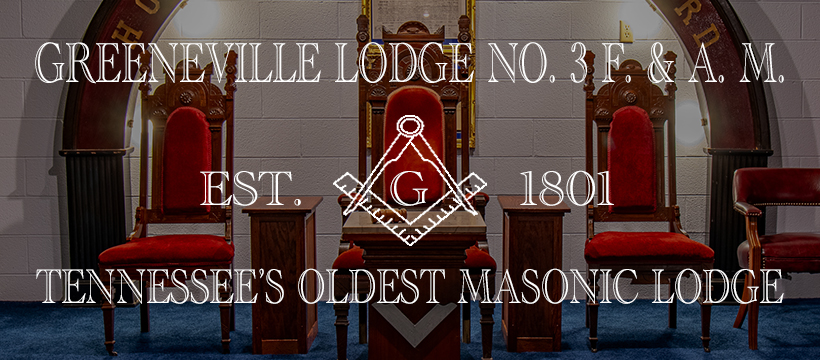Greeneville Lodge No. 3 History
(The following is an abridged version of a Greeneville Lodge No. 3 history by Joe Byrd)
Greeneville Lodge No. 3 Free & Accepted Masons has a rich history dating back more than two centuries. The Lodge is almost as old as the state of Tennessee itself and is actually older than the Grand Lodge of Tennessee. Among its members have been U.S. Presidents, war heroes, clergymen, policemen, firemen, public officials, industrialists, doctors, educators, and tradesmen. Whatever their station in life, some of the finest men in the history of Greeneville and Greene County have knocked on the Lodge’s door and sought admittance.
A complete and comprehensive history of the Lodge can never truly be written because of the passage of time. The records from the first half-century of the Lodge were lost, stolen, or destroyed when East Tennessee was gripped in the hands of the Civil War. The Lodge itself went dark from the late 1820s and late 1840s when anti-Masonic sentiments swept the nation. There have been boom times and lean times throughout the years. The Lodge has carried on through two World Wars and a Great Depression and even through modern times when worldly distractions have weakened men’s desire for fraternal fellowship.
Through it all, though, Greeneville Lodge No. 3 has endured and prospered, taking its rightful place as one of the cornerstones of Freemasonry in the state of Tennessee.
CHARTERS
(North Carolina Charter issued Dec. 8, 1801)
The Masonic Lodge in Greeneville has operated under three charters. The first charter was issued Dec. 8, 1801 and was issued by the Grand Lodge of North Carolina. The Grand Lodge of Tennessee issued our second charter in 1814, the year after Greeneville Lodge No. 3 helped form that august body. A third charter was issued to the Lodge in 1847 when Freemasonry began a resurgence in the United States following the dark days of the Morgan Affair.
The charter dated Oct. 6, 1814 and signed by Thomas Claiborne, first Grand Master of Tennessee, bears the Number 3, and this is the charter under which Greeneville Lodge meets and works still today.
(Restored Greeneville No. 3 Tennessee Charter)
Greeneville Lodge No. 3 is the oldest active Masonic Lodge in the state of Tennessee; St. Tammany (later re-named Harmony) Lodge No. 1 in Nashville and Knoxville Lodge No. 2 having ceased their labors many years ago. Masons in Greeneville were first granted a charter to establish their own Lodge on Dec. 8, 1801. This charter bore No. 3 of Tennessee and No. 43 of North Carolina. The charter was granted to Worshipful Master George W. Campbell, Senior Warden Jenkin Whiteside, and Junior Warden John Rhea. This charter is still in the Lodge’s possession and in safekeeping.
When the Grand Lodge of Tennessee was formed, the Lodge received its first charter from its own state. The Masons of Greeneville met in harmony under that charter for more than a decade, but when anti-Masonic fervor swept the country following the Morgan Affair, the Lodge ceased to meet and was ultimately stricken from the records of the Grand Lodge.
In the mid 1820s in New York, a man by the name of William Morgan threatened to publish an expose on Freemasonry. Morgan ultimately disappeared, and he was last seen in the company of men known to be Masons. Some say the group was merely giving Morgan a suggestion it was time to leave town; others claim he was murdered to keep him silent about the Craft. The murder talk picked up momentum, and before long, a wave of anti-Masonic sentiment washed over the entire country (http://www.masonicdictionary.com/morgan.html). It even gave rise to a new political party, the Anti-Masonic Party.
Greeneville, Tenn., was not immune, and the Lodge suffered. Greeneville Lodge No. 3 gradually ceased to meet after 1828 and stopped making returns to the Grand Lodge. On Oct. 4, 1838, the charter of Greeneville Lodge No. 3, along with those of more than 20 other Lodges across the state, was forfeited (John McKee; A Brief History, p. 27-28).
Sometime in the year 1846, after the excitement of the Morgan Affair had subsided, a group of Brethren from Greeneville decided to revive the Lodge. A petition to the Grand Lodge for a new charter was submitted. At the Annual Communication in 1847, Brother C.W. Nelson traveled to Nashville and returned home with a Masonic charter dated Oct. 8, 1847 and bearing the name Greeneville Lodge No. 119.
The Masonic Lodge in Greeneville operated under the No. 119 charter for 60 years until the Lodge made a request to the Grand Lodge to have our rightful number restored. In 1907 the request was granted, and the Lodge returned to labor under its original No. 3, which was still in possession of the Lodge.
Charles Snodgrass noted in his Freemasonry in Tennessee:
“… it petitioned the Grand Lodge to restore its original No. 3, citing its venerable origin under the Grand Lodge of North Carolina in 1801, its first charter from the Grand Lodge of Tennessee which it helped to found and which charter it still possessed, and its distinguished record, as a basis for this request; together with the fact that its twenty years dormancy was the direct result of the bitter persecution that prevailed during the Anti-Masonic disturbance – whereupon the Grand Lodge restored its old No. 3.” (p. 86)
The fact that the No. 3 charter survived to be restored is in itself a miracle. To be more accurate, the Lodge owes a great debt of gratitude to Brothers John Maloney and John M. McKee.
East Tennessee was one of the most hotly contested areas of the Civil War. The area, including the town of Greeneville, changed hands between Union and Confederate forces seemingly with the weather. Each time a larger army came through, downtown Greeneville became its headquarters, and the Lodge hall was prime real estate for tired soldiers looking for a place to bed down for the night. During the years 1861-65, most of the Lodge’s furniture, jewels, and records were lost to the ravages of war. McKee witnessed this firsthand.
As for the charter and some other items, here is McKee’s own account:
McKee and Maloney “… fearing that something might happen to the Lodge, as it had not met for a considerable time before this, took the charters and records then in use, beginning in November, 1857 (the other record books being locked up in the Secretary’s desk), the jewels, and some of the other articles, and hid them in the hotel then occupied by Brother Maloney, which stood on the ground now occupied by the M.E. Church on the southeast corner of Main and Summer streets [Asbury], by taking up a plank on the top of an old-fashioned cupboard built in between a chimney and the wall, and wrapping them up in an old blanket, placed them up in there, and then fastened back the plank. No one knew where they were but these two members, until after the war was over. When it was determined to reorganize the Lodge in 1865, they were ‘brought to light’ again.” (p. 26)
The debt of gratitude Greeneville Lodge No. 3 owes to these two brothers for their foresight and quick thinking can never be repaid.
PROMINENT MEMBERS
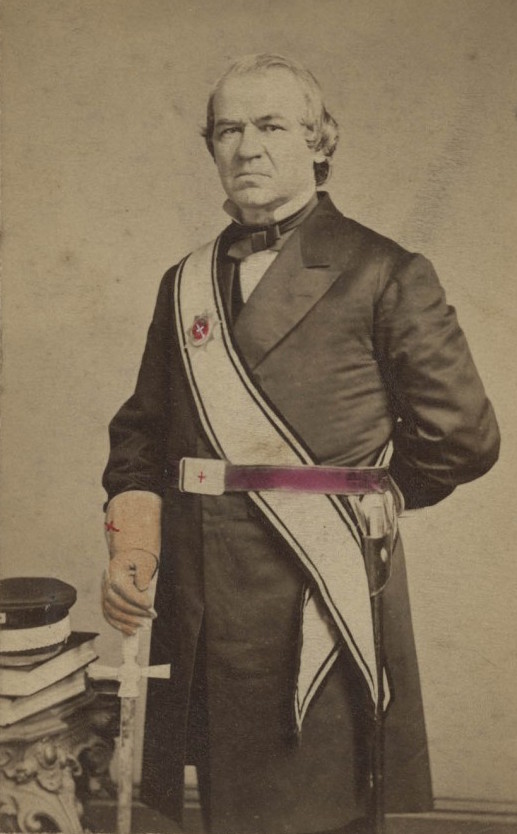
(President Andrew Johnson in Knight Templar regalia.)
Obviously, the most prominent member of Greeneville Lodge No. 3 is Brother Andrew Johnson. It’s not every Lodge that can claim a President of the United States as a member. In fact, Greeneville is one of only 14 lodges across the nation that can do so (excluding dual memberships, transfers, etc.).
Johnson received his degrees in what at the time was Greeneville Lodge 119 in 1851 and was a member when he passed to the Celestial Lodge Above in 1875. He would have received his degrees when the Lodge met in third story of a brick storehouse located at the southwest corner of Main and Summer streets, located across and diagonally from what would become Johnson’s homestead following his Presidency until his death.
Today, a mural of Johnson dressed in Knights Templar regalia looks over the site from across the street. The mural is painted on the building that was home to Greeneville Lodge No. 3 from 1908-1974.
The exact dates of Johnson’s three degrees were lost in the destruction of Lodge records during the Civil War. Some sources indicate he was initiated an Entered Apprentice Mason on May 5, 1851 (www.mn-masons.org). He was a Royal Arch Mason and Knight Templar. He probably would not have received these degrees in Greeneville as Capitular Masonry officially came to town while Johnson was living in the White House, and the first local Commandery wasn’t chartered until after his death.
Johnson was also a Scottish Rite Mason, receiving the degrees while living in the White House on June 20, 1867 (Snodgrass, p. 389).
Johnson died July 31, 1875. He was given full Masonic honors at his funeral in downtown Greeneville, and his body was escorted to its final resting place by Knights Templar in full uniform.
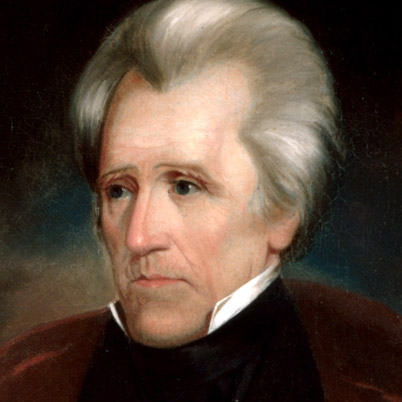
(President Andrew Jackson)
Johnson wasn’t the only United States President to sit in Lodge in Greeneville. Prominent Tennessean and future president Andrew Jackson is known to have been present on Sept. 5, 1801, sitting in the West as Senior Warden when the Lodge was still meeting under dispensation from the Grand Lodge of North Carolina.
Another of Greeneville Lodge No. 3’s more prominent members played a big role in the founding of the Grand Lodge of Tennessee. Rev. Stephen Brooks, a member of the Lodge from its earliest days (known to be on the Lodge Returns at least in 1803 if not before), was selected chairman of the committee which petitioned the Grand Lodge of North Carolina in 1811 to release jurisdictional control of its Lodges west of the Appalachian Mountains so they could form the Grand Lodge of Tennessee.
Rev. Brooks’ signature as chairman is attached to multiple letters and the transcript of proceedings from the meetings in Knoxville to establish a Grand Lodge of Tennessee. When the Grand Lodge was formed in 1813, Brooks was named the state’s first Grand Chaplain and served in that office for a number of years.
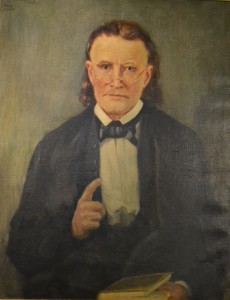
(Samuel Whitherspoon Doak founder of Tusculum College.)
Another prominent clergyman who was a member of Greeneville Lodge No. 3 was the Reverend Samuel Doak (1749-1830). A Presbyterian minister and pioneer in the settlement of what would become Tennessee, Doak famously delivered a fiery sermon to the Overmountain Men as they departed the area to go fight the British at the Battle of Kings Mountain during the Revolutionary War.
Later, Rev. Doak, along with fellow Lodge member Rev. Hezekiah Balch, went on to found what would become Tusculum College (1794), the oldest college west of the Appalachians.
Members of Greeneville Lodge No. 3 who have been elected to serve the state and nation include Senators Jenkin Whiteside and George W. Campbell and Congressmen John Rhea, William Dickson, Samuel Powell, and Oscar B. Lovette.
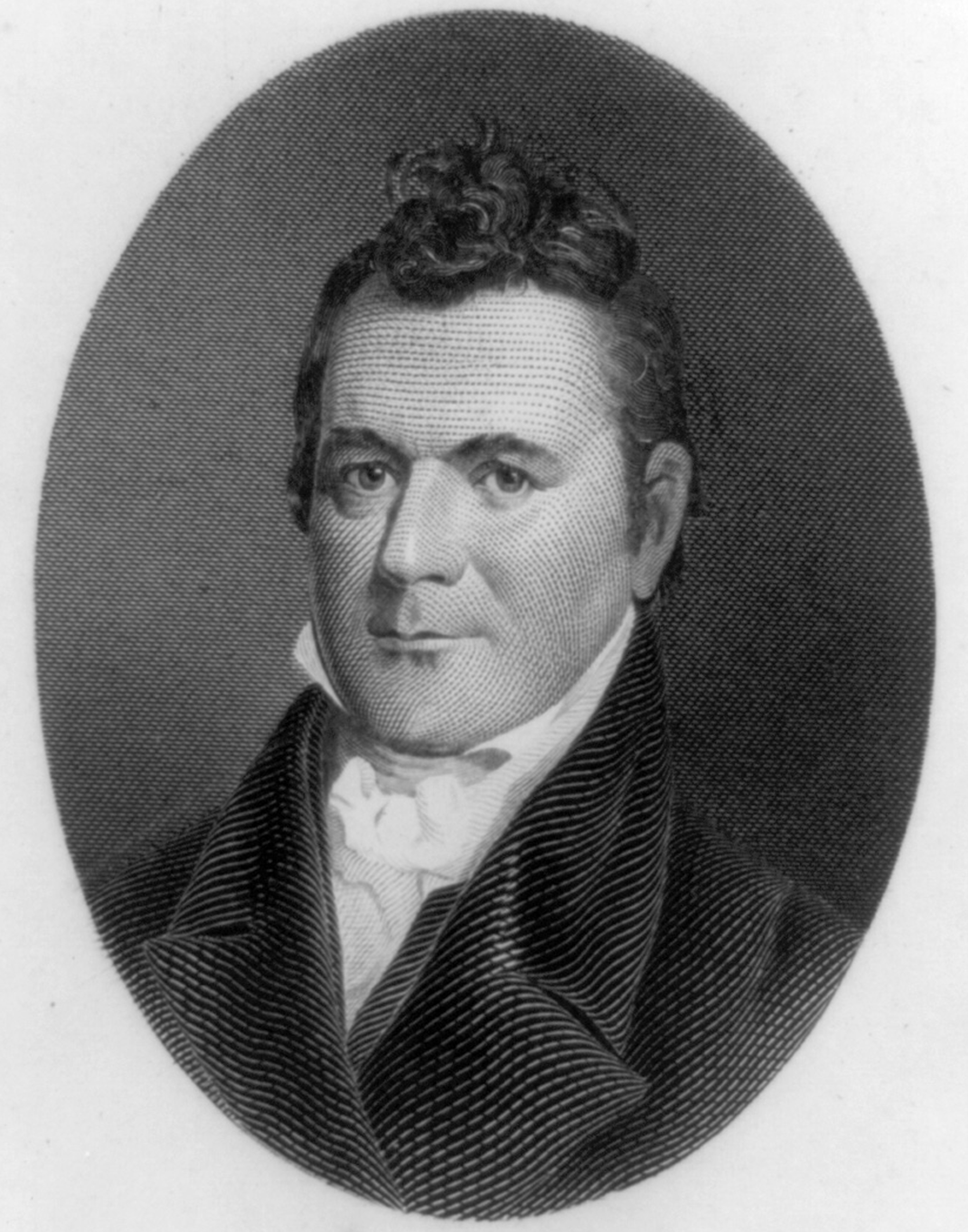
(George Washington Cambell first Worshipful Master of Greeneville Lodge.)
Campbell (1769-1848) served Tennessee as a U.S. Congressman, U.S. Senator, and state Supreme Court Justice. He served as the United States Ambassador to Russia, and was the fifth United States Secretary of the Treasury under President James Madison. Campbell was the first Worshipful Master of Greeneville Lodge No. 3, serving in that position its first two years of existence in 1801 and again in 1802.
Although never elected to national office, John M. McKee’s contributions to the Lodge and Masonry are immeasurable. As previously noted, it was through McKee’s efforts in protecting them during the Civil War that we still have our charter and other items. McKee (1840-1923) wrote one of the earliest know histories of the Lodge, and was in influential York Rite Mason.
Walter Brannan wrote of McKee in his 1957 Brief History:
“History of Greeneville Lodge No. 3 shows that Brother John M. McKee (better known to the brethren as “Mitch”) was one of the most brilliant and learned Masons to belong to Greeneville Lodge. Brother McKee was never married. It is not known where we was raised, but his entire Masonic life was devoted to the study of Masonry, which he so willingly imparted to the candidates and brethren.”
Major Leaguer Dale Alexander was a member of Greeneville Lodge No. 3. Alexander’s petition, dated Oct. 11, 1928 and still in possession of the Lodge, states his occupation simply as “baseball player.” Alexander was the American League batting champion in 1932 while playing for the Detroit Tigers.
One of the most important men in the modern history of Greeneville Lodge No. 3 is Brother Robert Ward.
Ward is a four-time Worshipful Master of the Lodge, serving in 1966, 1967, and 1969. Ward was given the honor as serving the Lodge as Worshipful Master again in its bicentennial year of 2001. He served as Secretary on multiple occasions, compiling the better part of three decades in that capacity. Many times it has been said of Brother Ward, “If it wasn’t for him, there wouldn’t be a Greeneville Lodge today.”
In A Brief History of the Lodge from 1992, Royce Peterson wrote:
“His Masonic career has been one of service and loyalty to the Lodge and all the Masonic brethren. He is … ever ready with his council, advice, and direction for anyone in need.” (p. 24)
While the brethren listed in this section certainly fall under the heading “Prominent,” it should in no way be considered a comprehensive list. The names of men who have quietly served the Lodge in its more than two centuries, served the community, served the state, and served the nation could fill volumes. Their contributions are no less important than any other.
